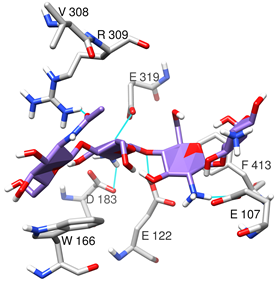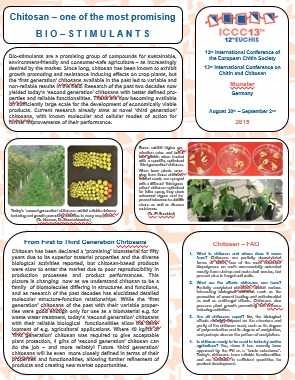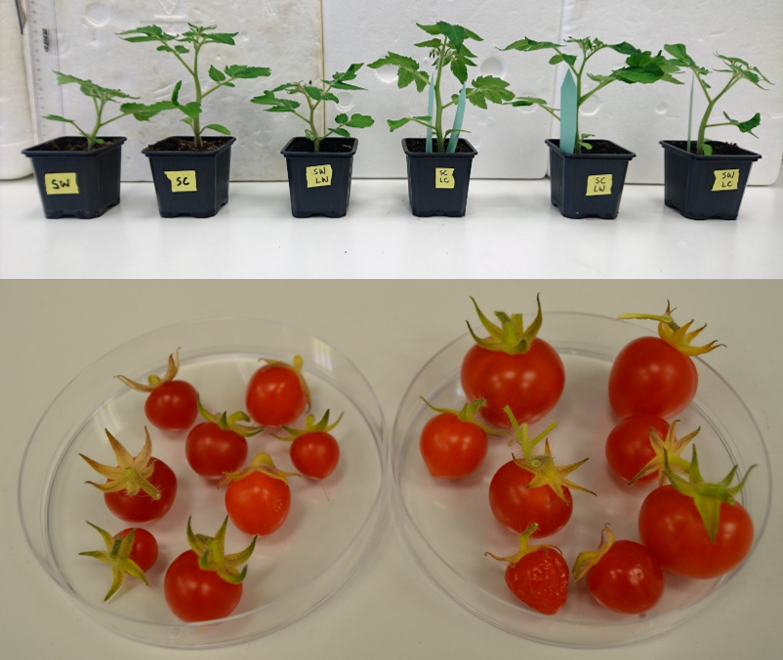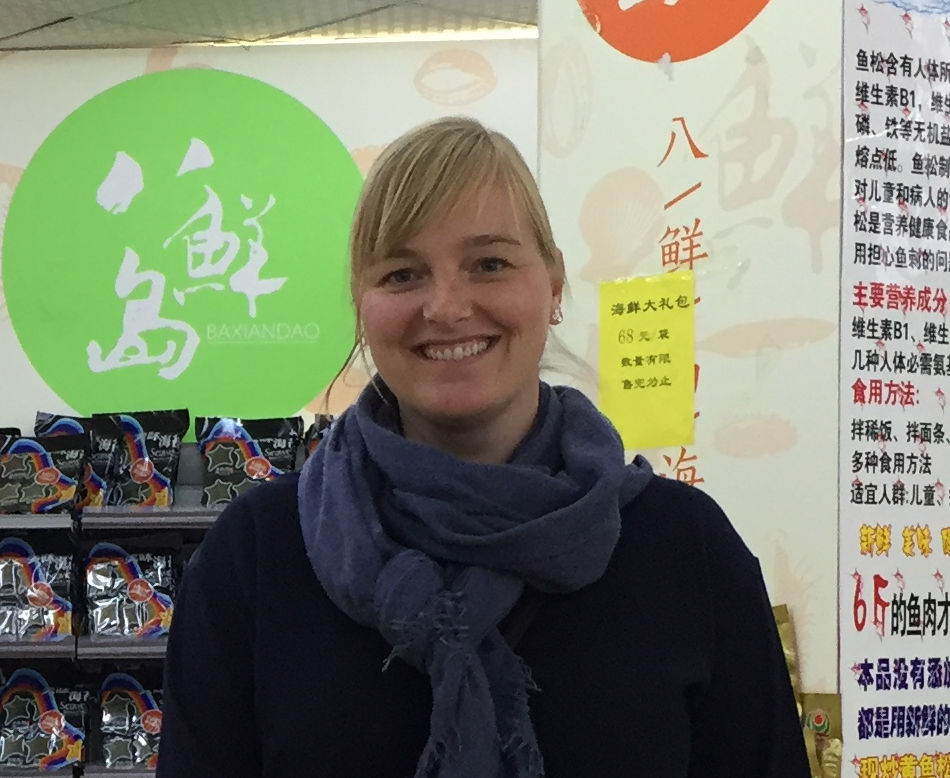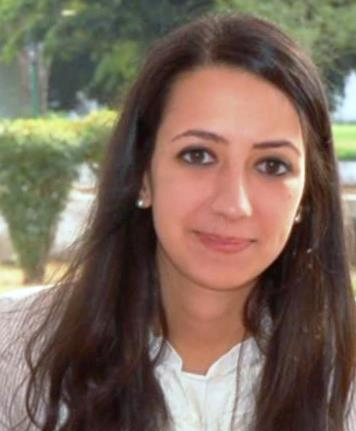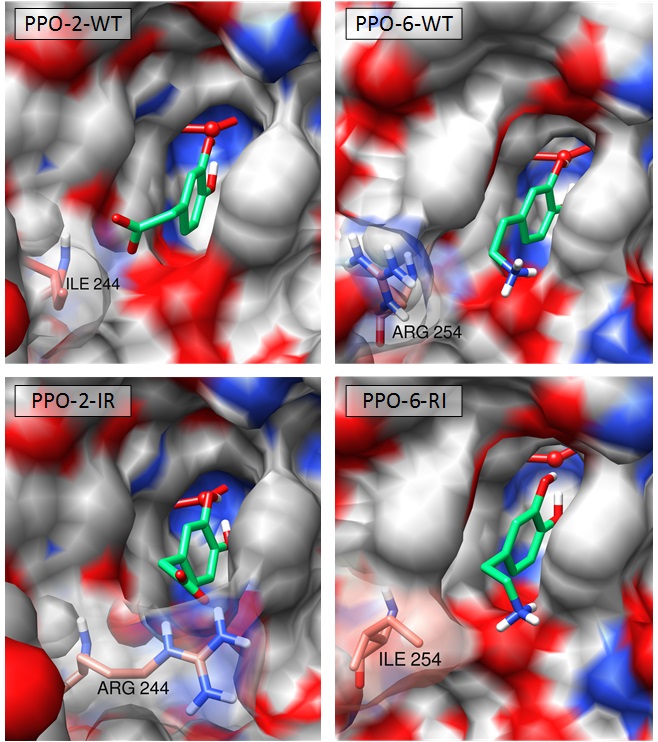News 2017
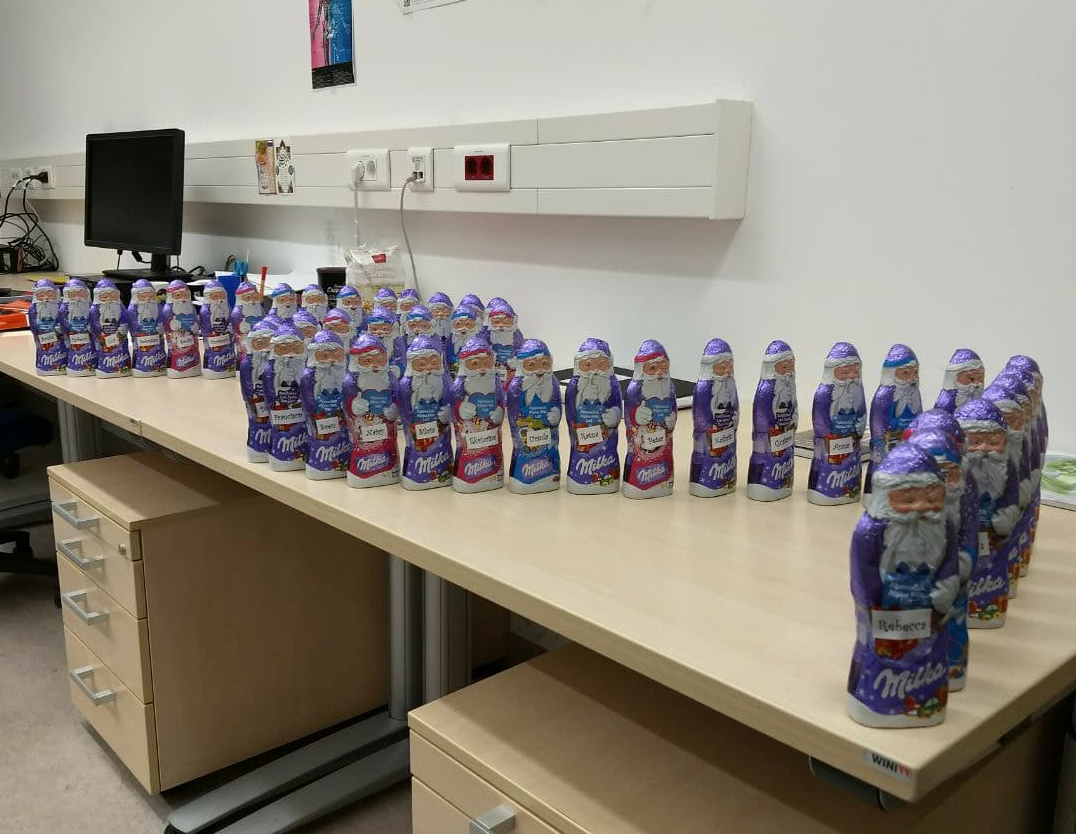

Weihnachtsfeier 2017
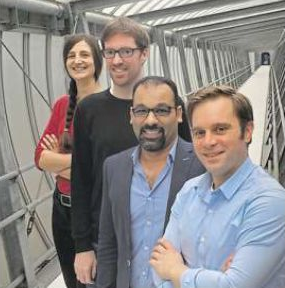

Evorion and Rebecca Melcher’s start-up in the press
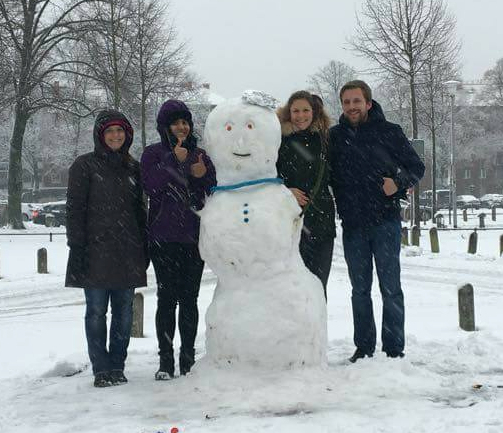

Sruthi’s first snowman
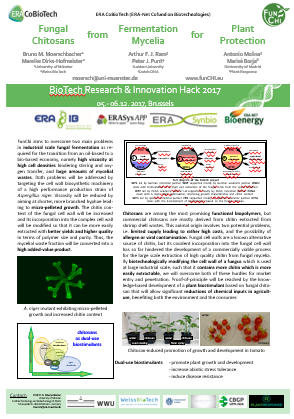

ERA CoBioTech Research & Innovation Hack in Brussels
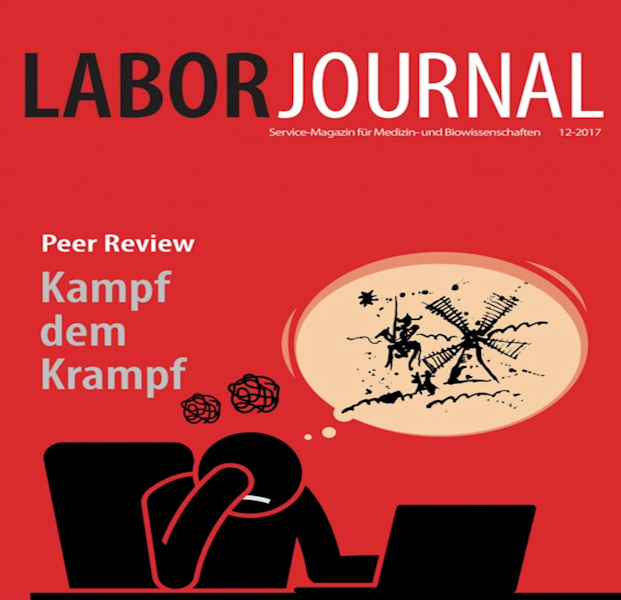

Evorion covered in Laborjournal
Paper accepted: “Enzymatic production of all fourteen partially acetylated chitosan tetramers using different chitin deacetylases acting in forward or reverse mode”
Lea Hembach and her co-authors’ paper on the biotechnological production of a full set of partially acetylated chitosan tetramers has just been accepted for publication in “Scientific Reports”.
Paper published: “Reassessment of chitosanase substrate specificities and classification
Tobias Weikert’s and his co-authors’ paper on a new classification system for chitosanases based on their substrate specificities has been published today in “Nature Communications”.
You can now subscribe to our Newletter
Philipp Lemke, with the support of the online press office of our university, has installed on option on our website to subscribe to our NEWS.
Paper accepted: “Synthesis, characterization and biological activities of biopolymeric Schiff bases prepared with chitosan and salicylaldehydes and their Pd(II) and Pt(II) complexes”
Today, Hellen Barbosa’s and Maha Attjioui’s and their co-authors’ paper on salicylaldehyde derivatives of chitosan and their complexes with palladium and platinum has been accepted for publication in a special issue of the journal “Molecules” devoted to chitosan derivatives and their applications.
Paper accepted:” Chitosan/cyclodextrin/TPP nanoparticles loaded with quercetin as novel bacterial quorum sensing Inhibitors”
Also today, Hao Thanh Nguyen’s paper on quercetin-loaded chitosan/cyclodextrin nanoparticles as a quorum sensing inhibitor was accepted for publication, by coincidence also in the journal “Molecules”.
Paper accepted: “A chitin deacetylase of Podospora anserina has two functional chitin binding domains and a unique mode of action”
Today, Janina Hossbach’s and her co-authors paper on characterisation of the first chitin deacetylase with two chitin binding modules was accepted for publication in “Carbohydrate Polymers”.
EXIST fellowship granted to Dr. Rebecca Melcher for preparation of her planned start-up biotech company
Already halfway through her doctoral project, Rebecca had had the idea to use her technical and scientific know-how to spin-off a start-up biotech company.
Paper accepted: “Chitosan analysis by enzymatic / mass spectrometric fingerprinting and in silico predictive modeling”
Today, Anna’s, Jasper’s, and their co-authors first paper on chitosan fingerprinting has been accepted for publication in “Analytical Chemistry”.
EUCHIS Newsletter No. 41
EUCHIS Newsletter No. 41 is available for Download now.
Sybille Hahne Gründerpreis for Evorion founders
Today, Hans-Kleine Brüggeney, Robert Weingarten and Dr. Sebastian Bühren received the Sybille Hahne Gründerpreis, one of the most highly endowed founders’ awards in Germany.
6th Indian Chitin and Chitosan Society Symposium - ICCSS
Our Indian Nano3Bio partner, Prof. Appa Rao Podile from University of Hyderabad, with whom we already collaborate successfully for more than ten years, had organised this year’s annual meeting of the Indian Chitin and Chitosan Society - ICCS in direct continuation of our Nano3Bio dissemination meeting, so that members of the society could easily attend the “Future of Chitosans” meeting, and the Nano3Bio partners could equally easily attend the ICCSS.
October 19, 2017: EUCHIS Newsletter No. 41
EUCHIS Newsletter No. 41 is available for Download now, click HERE.
September 20, 2017: Nano3Bio dissemination meeting on “The Future of Chitosans”
Directly following the final meeting of the Nano3Bio project, our Indian partners had invited some 500 colleagues and students from around the Hyderabad area to a one-day dissemination meeting entitled “The Future of Chitosans”. We - the Nano3Bio partners -presented our best results to them (to the extent that we can already disclose them) in oral and poster presentations, and they engaged us in vivid discussions - a very rewarding experience (and one that led to an estimated 10.000 selfies with us and Indian students!). Bruno Moerschbacher gave an overview of the project, its background and its goals, and different partners then presented their results concerning the different enzymes required for the biotechnological production of novel chitosans, namely chitin synthases, chitin deacetylases, transglycosylating chitinases, and engineered chitin glyco-synthases. In this, Lea Hembach from our group was in charge of presenting our work on chitin deacetylases. These talks were followed by examples of how chitosans and their nanoformulations can be used, e.g. for drug and gene delivery, for bone tissue transplantation, or for tumour diagnosis and therapy. Finally, the first comprehensive Life Cycle Assessment of chitosan productions was presented. We were overwhelmed by the keen interest our results met, but even more so by the warm welcome we received, most vividly expressed by the huge and beautiful Nano3Bio Rangoli on the floor of the Science Building of University of Hyderabad, created for us by two biology MSc students who had spent weeks planning it, and then worked on it all night long.
September 17-19, 2017: Final meeting of Nano3Bio in Hyderabad
The European research project “NanoBioEngineering of BioInspired BioPolymers - Nano3Bio“ will come to an end on September 30. Final meetings always stir up mixed feelings, of having to say a (hopefully transient) good-bye to colleagues turned friends, and of being proud to showcase the progress achieved during the project. In fact, we had to report many “firsts” that we have achieved, such as the first in vitro productions of chitin and chitosan polymers, production and analysis of the first chitosan polymers with non-random patterns of acetylation, the first report of natural chitosan production in plants, the first comprehensive Life Cycle Assessment of chitosan productions, etc. These have already resulted in a number of patent applications and scientific publications, and more of both will come in the near future. To support this, the meeting was preceded by a workshop on Scientific Paper Writing conducted by Dr. Richard Twyman, from Twyman Research Management in the UK, who helped us improving our most recent manuscripts, as he has done so successfully in the past. Given the spectacular results obtained and the huge promises the novel Nano3Bio chitosans hold, we are confident that Nano3Bio will yet again be the foundation of at least one follow-up project, together with some of the trusted Nano3Bio partners and certainly also new ones which will bring in additional expertise and fresh ideas. Off to new shores…
September 19, 2017: New Graduate School for “grEEn” batteries funded
Today, Prof. Pinkwart, Minister of Economy, Innovation, Digitalisation, and Energy of NRW, handed over the grant agreement with which a consortium of research groups from Münster and Aachen/Jülich will set up a new Graduate School termed “grEEn” to develop more sustainable battery technologies. These are urgently needed e.g. in electric cars or to store solar energy - especially given the results from different recent studies which estimated that the environmental impact of producing the batteries for an electric car may equal that of driving this car for an average of eight years! grEEn is coordinated by the team of Münster Electrochemical Energy Technology - MEET in the Faculty of Chemistry, and it will involve three groups from our institute. In our group, two doctoral students, Rita Weyer and Max Linhorst, will produce different chitosans and chitosan derivatives as alternative electrode materials, to be tested for their performance in batteries in collaboration with MEET partners, in particular Dr. Gunther Brunklaus. This will be a challenging new area of research for us, focusing on the material properties rather than on the biological functionalities of chitosans. We trust that our experience gained in two decades of research into structure-function relationships of bioactive chitosans can also contribute to develop chitosan-based materials for the bioeconomy.
September 15, 2017: Eight new young scientists with a BSc in Biosciences
Today saw this year’s Bachelor celebration where around one hundred young scientists received their Bachelor certificates from the University of Münster, among them three who performed their undergraduate projects in our group, namely Margareta Hellmann, Anna Klaverkamp, and Jamie Lötzer, three who worked at our funCHI partner Plant Response Biotech in Madrid, namely Jos Cox, Jan Erdmann, and Max Evers, and two who worked in groups of the Medical Faculty here in Münster, namely Jan-Philipp Kamps and Sandra Schorn. Margareta worked with Stefan Cord-Landwehr to transfer his quantitative mass spectrometric sequencing of partially acetylated chitosan oligomers to that of partially methyl-esterified pectin. She managed to deliver the last decisive data which led to the acceptance of the respective manuscript on which is now a co-author. Anna performed, supported by Marten Neumann and Ratna Singh, knowledge-guided site-directed mutagenesis of the first ulvan binding domain and succeeded in identifying a range of amino acid residues which are involved in substrate binding. Jamie Lötzer worked with Philipp Lemke on our recently found synergistic effect of chitosan oligomers and polymers, an exciting observation which we think might be of great value if only we understood the effect better - and this is just what Jamie helped us to do. We are convinced that also both Anna’s and Jamie’s work will eventually become part of well-placed papers!
August 20-24, 2017: 5th EPNOE International Polysaccharide Conference
More than 250 participants from 49 countries joined the 5th EPNOE (European Polysaccharide Network of Excellence) meeting held in Jena, Germany. It was arranged by the Centre of Excellence for Polysaccharide Research Jena-Rudolstadt, represented by Prof. Dr. Thomas Heinze from the Friedrich Schiller University and Dr. Frank Meister from the Thuringian Institute for Textile and Plastics Research Rudolstadt. At the conference, PhD students and experts from both academia and industry exchanged experiences and presented their results about the synthesis, extraction, characterization, chemical and enzymatic modification of polysaccharides and polysaccharide-based products as well as their applications. Three PhD students from our group contributed to the conference: Eva Regel gave a talk about the engineering of a chitosanase to change its substrate specificity and thus the range of producible partially acetylated chito-oligosaccharides (paCOS). In addition, the spectrum of paCOS was further broadened by the successful engineering of chitin deacetylases as presented on Rita Weyers poster. Hellen Barbosa showed her results on the characterization and toxicity of Schiff bases from chitosan and drug release profiles of quercetin-loaded chitosan nanoparticles on two posters.
Start-Up funding secured
Congratulations to Hans Kleine-Brüggeney, Robert Weingarten and Sebastian Bühren! Following the first phase of start-up funding by the EXIST programme of the “Bundesministerium für Wirtschaft und Energie”, this team of young researchers associated to the joint Moerschbacher / Goycoolea group again secured significant funding, now from the “Ministerium für Innovation, Wissenschaft und Forschung NRW”, to support the foundation of EVORION® Biotechnologies, a biotech start-up company. EVORION is developing innovative technologies for cell-based biomedical research and development. The products are based on microfluidic technologies that allow for multiparametric real-time analysis of cell populations at single-cell resolution. The technology will enable new insight into cellular communication within physiologically relevant 3D environments and will help to uncover new strategies for cell-based therapies. Their work successfully combines fundamental research at the frontiers of cell biology and development of tools and applications with a direct benefit. Our university WWU, our group from the institute IBBP, the technology transfer team of the university AFO, and the Centre for NanoTechnologies CeNTech all support the EVORION team, and they in return offer exciting possibilities for selected students to perform projects in the framework of research modules or Master theses in an environment with a difference. More information can be found at www.evorion.de soon.
July 11, 2017: Frauke Lankamp successfully defended her MSc thesis
For her Master thesis, Frauke worked in the framework of our European Nano3Bio project, in close collaboration with our industrial partner Artes Biotechnology in Langenfeld, Germany, aiming to heterologously express a chitin synthase and/or a chitin deacetylase of the human pathogenic fungus Cryptococcus neoformans in the yeast Hansenula polymorpha, first supervised by André Nordhues and later by Lea Hembach. Prof. Jose from the Institute for Pharmaceutical and Medical Chemistry joined us for the defense. Frauke had succeeded in obtaining enzymatically active chitin synthase and chitin deacetylase proteins by heterologous expression. While we already had some previous successes with the difficult to express fungal chitin deacetylases, this was our first, and one of the first-ever, successfully expressed full-length fungal chitin synthase. Together with André, she also developed a new mass spectrometric assay for chitin synthase activity determination, allowing her to characterize the enzyme - this should give a nice paper. And the chitin deacetylase is the first one expressed and characterized from C. neoformans, so this should also be publishable well. All in all, an excellent output! And congratulation to Frauke also for being probably our first Master student who already has secured a job even before obtaining her degree.
July 2-6, 2017: 19th European Carbohydrate Symposium EuroCarb 2017 in Barcelona
The biannual EuroCarb meetings began almost fourty years ago with a small meeting devoted to carbohydrate chemistry, and it has grown ever since. This year’s meeting, perfectly organized by Prof. Toni Planas from Ramon Llull University in Barcelona and his team, has attracted almost 700 participants from all over the world. Also, Toni successfully made an effort to strongly develop this meeting into one that bridges glyco-chemistry and glyco-biology, making it highly interesting to us. Bruno Moerschbacher was invited to chair the Nano3Bio session devoted to disseminating the results of our European project, and he also gave a key note lecture to start this session. Stefan Cord-Landwehr and Marten Neumann presented their work on posters. Stefan described his mass spectrometric sequencing approach for chitosan oligomers and its use in defining the subsite specificities of chitosan degrading enzymes. Marten Neumann described his revised annotation of an ulvan lyase gene which had revealed the first ulvan binding domain, and its characterisation. Of course, we met with many colleagues with whom we have collaborated in the past or are doing so just now, not only in the framework of Nano3Bio, and it was an excellent opportunity to also think about and start defining future joint projects, which we did successfully. We think this could become a conference to visit more regularly in future.
July 3, 2017: Rita Weyer and Max Linhorst started their PhD projects
Even though we are still waiting for the formal letter approving the Graduate School on “Grüne Elektrochemische Energiespeicher - Green Electrochemical Energy Storage - grEEn” coordinated by the Münster Electrochemical Energy Technology - MEET, Rita Weyer and Max Linhorst started today their PhD projects which will contribute to the development of more sustainable batteries. There are a few scattered reports in the literature suggesting that chitosan might be a suitable alternative electrode material for cheaper and more environment-friendly batteries. However as usual, the chitosan used in these applications was not characterised at all, neither regarding its purity nor regarding its composition. We therefore proposed to start a more systematic investigation into the influence of the molecular structure of chitosans and their suitability for use in batteries. To this end, we will need to scale-up the production of our well-defined chitosans, and we also plan to improve their properties by chemical or enzymatic functionalisation. Rita did her Master thesis in a collaboration between our group and the BioBase Europe Pilot Plant in Ghent in the framework of our joint Nano3Bio project where she scaled up the biotechnological production of well-defined chitosan oligomers. Max did his Master in Biochemistry at Ruhr University Bochum engineering a decarboxylase for asymmetrical synthesis and, thus, has a strong background in both chemistry and biotechnology. So both have perfectly matching qualifications for our project - welcome to our team!
July 3, 2017: Nano3Bio dissemination session at EuroCarb 2017 in Barcelona
During the 19th European Carbohydrate Symposium EuroCarb 2017 organised in Barcelona by our Nano3Bio partner Prof. Toni Planas, one of the four parallel afternoon sessions on Monday was fully devoted to our European research project Nano3Bio. First, Bruno Moerschbacher gave an introduction and overview of the whole project, explaining why we aim to develop biotechnological ways to produce well-defined chitosan oligomers and polymers with non-random patterns of acetylation. Prof. Marjan de Mey from Ghent university then explained how metabolic engineering can improve yields and purity of the monoclonal chitosan oligomers we produce in bacteria; Prof. Francisco Goycoolea from Leeds university described different nanoformulations of chitosans and who they can support gene delivery and novel antimicrobial strategies based on quorum quenching; and Dr. Christian Gorzelanny from Mannheim/Heidelberg university showed how chitosan-based nanocapsules can be targeted to tumour vessels, delivering potential cargo drugs to their target site. Finally, Stefan Cord-Landwehr from our lab and Hugo Arabunde from Toni’s lab had selected to present their posters on quantitative mass spectrometric sequencing of partially acetylated chitosan oligomers and on a screening strategy to identify optimized versions of a bacterial chitin deacetylase from a mutein library, respectively, in short talks. Our session was well-visited and we had very good (and a bit too long) discussions which extended into the poster session afterwards where we were approached by a good number of colleagues from around the world who were quite impressed by our results and interested in future collaborations. A few projects, e.g. with Prof. Isabelle Compagnon in Lyon and with Dr. Gregor Tegl in Canada, have already been firmly defined - an excellent result of our dissemination meeting.
July 2, 2017: Paper accepted: “Chitinosanase: a fungal chitosan hydrolyzing enzyme with a new and unusually specific cleavage pattern”
Finally! This paper has been in the making longer than any other before, I cannot even guess how long. I believe it was Nouri who first identified the enzyme, Markus Kohlhoff did the first purifications and characterisations and realised that this enzyme is special, differing from all known chitinases and chitosanases, Frank Bernard supported this notion by first MS studies of the products, Julie Bénéteau and Gustavo Rivera-Rodriguez spent part of their postdoc time hunting for the gene encoding the enzyme, Stefan Cord-Landwehr refined the MS analyses and finally, Anna Niehues and Jasper Wattjes provided final proof for the unusual subsite specificities of the enzyme which now defines a new class of chitosan hydrolases. In contrast to chitinases which are defined by their ability to cleave fully acetylated chitin oligomers, and in contrast to chitosanases which are defined by their ability to cleave fully deacetylated chitosan oligomers, our new chitinosanase cleaves neither, because it requires a deacetylated GlcN unit next to an acetylated GlcNAc unit in order to bind and cleave its substrate. It is therefore able to hydrolyze partially acetylated chitosan oligomers and polymers, and it is an ideal tool for enzymatic / mass spectrometric fingerprinting analyses of the degree and pattern of acetylation of chitosans. This will be the story of some follow-up papers which we can now finally submit, too - now that this paper describing the enzyme has finally been accepted for publication in “Carbohydrate Polymers”.
June 27, 2017: Anna-Lena Falz successfully defended her MSc thesis
For her Master thesis, Anna-Lena worked under the direct supervision of Anne Vortkamp and Philipp Lemke in a project which, based on the spectacular results of our Indo-German 2+2 project CuChi-BCA, we had designed in collaboration with the company Compo Expert here in Münster. Compo Expert is developing fertilizers for the agro-industry, and plant biostimulants are an emerging, promising extension of this field and, possibly, market. We have a strong background in chitosans as a biostimulant and we had shown in the CuChi-BCA project that it is possible to combine chitosan with Trichoderma as a biocontrol agent. Compo Expert is using biocontrol Bacillus strains in some of their products and so it was only logical to try and combine chitosans with a selected Bacillus strain. Initial experiments aiming to identify the best suited chitosan that would be compatible with Bacillus were quickly successful, but verifying a synergistic effect in planta proofed much more difficult. Anna-Lena had to establish a number of new assay systems, both in our labs and at the Compo Expert facilities, before she finally succeeded in showing that in deed, the two biostimulants can be combined to exert a synergistic effect on plant root growth. Dr. Mauricio Hunsche from Compo Expert, who was also her second examiner in the thesis defense, expressed his interest in future collaborations based on Anna-Lena’s results - an excellent outcome of her MSc project! - which we are sure will also help her find an appropriate position for her further career.
June 22, 2017: “Goldener Hans” for best teacher in the biosciences at WWU Münster University awarded by students to Bruno Moerschbacher
Prof. Hans Kaja must have been an inspiring and beloved professor at the Faculty of Biology of the University of Münster. When he retired in 1991, the students awarded him with a special thank you price in the form of a golden mouse in a talar giving his students a “thumbs up”. Prof. Kaja suggested the students to make this into a Challenge Cup to be awarded every other year to the best teacher of the Faculty. And this is what it is today. Receiving it is the highest honour for any biology teacher at WWU who cares for his students. This year, Prof. Moerschbacher was elected by the students, and the cup was awarded during this year’s Summer Party of the Fachschaft. Already from 2003 to 2005, it had occupied pride of place in Bruno’s office - and if you know his office, you will know that this is not easy. In fact, some tidying up will now be required lest it would be buried quickly under a pile of papers. Receiving the Goldenen Hans not only is an honour, it also represents a challenge: not to relent, but instead to keep improving one’s teaching. Each generation of students is a new challenge and a new opportunity, and it is amazing to see how each year, new enthusiastic students appear, devoted to studying biology out of interest, out of a desire to help combat diseases and secure a sustainable food supply, but also out of a deep felt responsibility towards nature and man’s respectful association with it. The Goldene Hans is a reminder that this is the most noble task of a university teacher: to support students to fulfil their dreams.
June 22, 2017: Paper accepted: “Preparation and optimization of submicron chitosan capsules by water-based electrospraying for food and bioactive packaging applications”
Sruthi Sreekumar’s and Philipp Lemke’s paper on optimizing conditions for electrospraying as an alternative way for producing chitosan nanoparticles has just been accepted for publication in “Food Additives and Contaminants”. This paper is a result of a short collaboration with the group of Prof. Lagarón at the Institute of Agrochemistry and Food Technology in Valencia, Spain, an expert in electrospraying and electrospinning. This is a rather new technique with great potential as it allows the formation of particles or fibers without the need for organic solvents or heat treatments and, thus, the inclusion of sensitive “payloads” such as drugs, genes, vaccines, enzymes, etc. While the preparation of chitosan particles by electrospraying has been described before, this is the first systematic investigation on the influence of parameters such as the degrees of polymerization and acetylation of the chitosan used, and its concentration. Not surprisingly, we found that chitosan oligomers, which are best for many biological applications, cannot be electrosprayed because their solution lacks viscosity, while chitosan polymers, which are best for antimicrobial applications, cannot easily be electrosprayed because their solution lacks sufficient conductivity. Interestingly, we found that mixtures of oligomers and polymers are easily electrosprayable and, under optimized conditions, yield rather uniform particles. However, these particles are not stable in aqueous solutions - this is our next challenge.
June 21, 2017: Paper accepted: “Discrimination of patterns of N-acetylation in chitooligosaccharides by gas phase IR”
Jasper Wattjes’ first paper on a new “hyphenated” technique, namely MS-IR, for the sequence characterization in partially acetylated chitosan oligosaccharides has been accepted for publication in “Pure and Applied Chemistry”. This is the result of a short research stay which Jasper spent in Prof. Isabelle Compagnon’s lab in Lyon, France. She is a leading expert in developing new analytical tools, particularly using different spectroscopic techniques. She had recently „drilled a hole into her MS instrument and attached an IR beam to it“, allowing her to simultaneously record MS and IR spectra of minute amounts of compounds. Jasper brought with him some of our fully defined chitosan oligomers, namely the four mono-deacetylated and two doubly-deacetylated tetramers, and he developed a robust fingerprinting analysis for their patterns of acetylation. Such an MS-IR instrument is not yet available on the market, but it might be soon. And Jasper and Isabelle are already discussing to extend the fingerprinting to analyse the patterns of acetylation of partially acetylated chitosan polymers. We believe this to be a very significant contribution as we have speculated that the pattern of acetylation to a large extent governs the biological activity of chitosans, but chitosans with defined, non-random patterns of acetylation are not yet available, and even analytical techniques for their detailed characterisation are still in their infancy.
June 19 - 20, 2017: Mini-Symposium of AG MOE&GOY
This year, we had our annual two-days Mini-Symposium in the Kettelerscher Hof in the heart of Münster, for the first time with our large joint groups. It was planned and organized by Eva, Lea, Sarah, and Tamara, supported by Cordula, Ursula, Claudia, and Sabrina (where were the men?). All Master students, doctoral candidates, and postdocs presented their projects on posters in five poster sessions with five posters each, while our Bachelor students presented their projects in four seminars. On Monday afternoon, we split up in two parallel workshops, learning how to deal with stress and procrastination, or working out ten power rules for publication. And our Tuesday session began with a one-hour yoga class, stretching our bodies before again stretching our minds. All posters were excellently done (and all except for two won the third poster price, while Lea received the second and Jasper the first poster price!) - and being as we are a rather large group, everyone detected a method or result surprising her or him on at least one poster. Overall, the Mini-Symposium invigorated our drive for compiling and submitting our results for publication (and sometimes, patenting first), and it helped fostering the team spirit which is so paramount for success in a large, international, and interdisciplinary group. Of course, the strongest inspiration came from Monday evening’s barbecue in the IBBP-Innenhof to which our Bachelor and Master students had invited us. Thanks go out to all who helped make this Mini-Symposium another success!
May 31 - June 3, 2017: 13th International Conference of the European Chitin Society EUCHIS and 8th Symposium of the Iberoamerican Chitin Society SIAQ
We were a large group from our labs visiting the meetings of EUCHIS and SIAQ which this time were jointly held in Sevilla, Spain: Bruno Moerschbacher and Nour Eddine El Gueddari, our post-doc Stefan Cord-Landwehr, our doctoral candidates Anna Niehues, Jasper Wattjes, Marten Neumann, and Philipp Lemke, our Bachelor candidates Jamie Lötzer, Jan Erdmann, Jos Cox, and Max Evers, as well as the doctoral candidates Christoph Engwer, Hao Nguyen, Stefan Hoffmann, and Tamara Mengoni from the Goycoolea group. Francisco Goycoolea was also there, as well as our Nano3Bio partners Christian Gorzelanny, Ivan Munoz, Katja Richter, and Toni Planas, our ChitoGrow partners Katja and Andreas Heppe and our F2F partner Elvira Sgobba - and of course, we met many friends from previous projects and conferences, particularly the last EUCHIS / ICCC meeting which we had organized in 2015 in Münster. During the conference, Bruno Moerschbacher was elected President of EUCHIS and Stefan Cord-Landwehr was awarded the prestigious Braconnot prize which EUCHIS gives every other year for the best chitin/chitosan-related PhD thesis of the past two years. He closed the meeting with his plenary Braconnot Lecture in which he described his development of quantitative mass-spectrometric sequencing of chitosan oligomers and its use for the characterization of a chitin deacetylase from the plant endophytic fungus Pestalotiopsis.
June 2, 2017: A very sad news reached us today: Prof. Dr. Kjell Vårum, a partner of our first European project CARAPAX and ex-president of EUCHIS, is no more
Today, during the EUCHIS Board meeting, we were informed that our friend and colleague Kjell Vårum from the University of Trondheim in Norway passed away. With him, we have lost a real pillar of international chitosan research. Of the many scientific breakthroughs which we owe him, perhaps the most influential was his dedication to continuously improving the methods for structural characterization of chitosans, in particular using NMR techniques. Not only are today’s “gold standard” protocols for the determination of degrees of acetylation based on his work, he also pioneered the diad analysis for the determination of patterns of acetylation using 13C-NMR as well as early fingerprinting protocols for chitosan analysis. Our work of the past twenty years on elucidating structure-function relationships of partially acetylated chitosans took its origins from a meeting of Bruno Moerschbacher with Kjell and his French colleague Alain Domard, both of whom donated precious, well-characterised chitosan samples for Bruno’s first studies on the influence of the degrees of polymerization and acetylation on biological activities of chitosans. Their joint paper resulting from this collaboration is today considered a milestone in the development of second generation chitosans. It also was the basis for the CARAPAX project which took up this line of research, and which was followed by the highly successful series of EU projects which have sustained our lab to this day. Clearly, Kjell, we owe a lot to you - thanks!
May 29-30, 2017: half-annual meeting of the “FunChi” project in Madrid
This year’s Spring meeting of the European Research Area - Industrial Biotechnology research project FunChi was organized by Prof. Antonio Molina from the renowned Centre of Biotechnology and Genomics of Plants at the Polytechnical University of Madrid. Our Spanish industrial partner Plant Response Biotech (where three of our Münster students are currently doing their Bachelor projects) has its laboratories at the same place. Our German industrial partner Weiss BioTech was represented by Dr. Mareike Dirks-Hofmeister, and our Dutch academic partner Leiden University by Prof. Arthur Ram and Tim Leeuwe, while Prof. Peter Punt from Dutch DNA unfortunately could not join the meeting. From our group, Bruno Moerschbacher and Nour Eddine El Gueddari were accompanied by Anna Niehues, Soofia Khanamadi, and Jasper Wattjes who like all partners, presented their results of the first year of the project, and defined the plans for the coming six months. Most importantly, we decided on joint protocols for the isolation and characterization of the fungal cell walls and of the chitin extracted from them. We also agreed on additional materials such as reference chitosans and Arabidopsis strains to be exchanged and on exchange visits of our students to make best use of the synergistic potential of the different competences and infrastructures of the project partners. We will meet again in January 2018 in Leiden in the Netherlands.
May 18, 2017: Welcome AG Goycoolea and farewell to Christine, Rebecca, and Anne
Today saw the first joint social activity of the groups of Profs. Bruno Moerschbacher and Francisco Goycoolea after Francisco left as and became Chair of Biopolymers at University of Leeds in the UK last November. His remaining group at our institute in Münster has moved from their cozy and spacious old labs in Schlossgarten 3 to more modern, but also much smaller labs in Schlossplatz 8 at the end of last month. This had to occur since the Schlossgarten will be renovated into the House of Students of our university later this year, but it also brought them closer to us, which we appreciate. Already, we have joined our weekly labmeeting on Wednesday mornings so that our seminar room can hardly accommodate us all. And we also join in the weekly Journal Club on Fridays. To welcome them, we enjoyed today a canoe trip on the Werse followed by a rich barbecue in the Innenhof. At the same time, this was the farewell party of Drs. Christine Leufken, Rebecca Melcher, and Anne Vortkamp who left us after obtaining their doctoral degrees. All three of them are already on very different and promising career tracks for which we wish them continuous success, hoping to hear from them often and to also see them regularly in future!
May 12, 2017: 39th EUCHIS newsletter
Just in time for EUCHIS 2017 in Sevilla, EUCHIS Newsletter No. 39 is available now for download here (direct link).
April 1-9, 2017: Bruno Moerschbacher visited US and China
Prof. Bruno Moerschbacher was invited to give an oral presentation during this year’s Spring meeting of the American Chemical Society in San Francisco held in San Francisco, during a three day symposium to honor Kevin Edgar who received the 2016 Anselme Payen Award from the Cellulose and Renewable Materials Division of ACS. The presentation on “Enzymatic control of chitosan acetylation” was well received, and plans for future collaborations with Kevin were discussed. Bruno then continued to Linshu in the Shandong Province of China where he was invited as one of seven European experts to contribute to the First International Conference on Biostimulants. His talk there was entitled “Second generation chitosans for reliable performance in crop nutrition and crop protection”. Other experts included Dr. Arnaud Cayrafourcq (EBIC/Prospero, Belgium), an expert on the EU biostimulant market and legislation, Dr. Franck Hennequart (Algaia, France), Dr. Adriano Altissimo (Landlab, Italy), and Dr. Alexander Schouten (University of Wageningen, Netherlands), experts on seaweeds, amino acids, and microorganisms as biostimulants, respectively, as well as Dr. Victoria Fernandez (University of Madrid, Spain) and Dr. Heiner Goldbach (University of Bonn, Germany), experts on the uptake of biostimulants through leaf and root surfaces, respectively. The group found their expertise mutually synergistic and, therefore, decided to intensify their contacts and work towards future collaborative research projects.
March 24, 2017: Maha Attjioui successfully defended her PhD thesis
Today, Maha Attjioui successfully defended her PhD thesis with a public presentation and discussion of her research results followed by a closed examination with her doctoral committee consisting of the professors Bruno Moerschbacher, Francisco Goycoolea from Leeds University, and Johannes Hallmann from the Julius-Kühn Institute here in Münster. Maha has a background in agricultural studies, and she wanted to try and bring our “second generation chitosans” developed and biotested in the lab and now produced on industrial scale by our partner Dominique Gillet in India, to the fields of her native Morocco to explore their agricultural potential under real life conditions. When we had earlier compared chitosan treated plants with non-treated control plants, Maha benchmarked the performance of our best chitosans against standard practices applied in the field, i.e. either full chemical plant protection measures or established biocontrol approaches. Financially supported by a doctoral fellowship from DAAD, Maha’s work stretched all the way from molecular and bioanalytic work in the lab to applied field work performed in the greenhouses of Les Domaines Royales in Morocco. And she not only proved that our chitosans outperformed even standard chemical plant protection treatments, but she also gained new insights into their modes of action. Her work marks an important milestone on our way towards reliable and sustainable, chitosan-based plant protection.
March 16, 2017: half-annual “F2F” consortium meeting in Zwingenberg
This year’s spring meeting of the ZIM project F2F was organized by Dr. Mareike Dirks-Hofmeister from one of our industrial partners, the biotech company Weiss BioTech, in the premises of B.R.A.I.N in Zwingenberg near Darmstadt. From Münster, Bruno Moerschbacher and the doctoral researchers Marina Vortmann and Soofia Khan Ahmadi from our group, Bodo Philipp and his doctoral candidate Anna Stumpf from the IMMB, and Nicolas Taylor from the biotech start-up Cysal participated, while Volker Wendisch and his doctoral candidate Elvira Sgobba joined us from the University of Bielefeld. Again, the progress made since our last meeting half a year ago was impressive: two years into the project and one year before its end, the invention phase is successfully terminated and we are in the innovation phase now. Proof-of-principle is shown for all the steps required for building a bacterial consortium to convert the chitin in waste fungal biomass from industrial fermentation processes into valuable amino acids and dipeptides. We defined three joined publications for which the bulk of results are already available and which we hope to submit until our next meeting in fall. We also agreed upon the next steps to be taken by all partners to further optimize the individual steps and, most importantly, their integration into an economically feasible and sustainable production process.
March 13, 2017: Pascal Poweleit successfully defended his MSc thesis
Pascal Poweleit had worked for his Master thesis partly in our group and partly in the grou of Prof. Marjan de Mey at the University of Ghent, one of the academic partners of our current European research project Nano3Bio. His second referee had been Prof. Francisco Goycoolea who returned with us from the Nano3Bio consortium meeting in Barcelona to attend the defense. Pascal wanted to extend the molecular genetic tools available for Corynebacterium glutamicum which we are using as an alternative bacterial cell factory for the production of fully defined, partially acetylated chitosan oligosaccharides. To this end, he worked towards establishing the CRISPR/Cas9 system in C. glutamicum, to ease metabolic engineering. As a second part of this work, Pascal developed a computational work flow for the analysis of large data sets as obtained during optimization of gene expression for metabolic engineering in microtiter plate format. Pascal has been a great help when working with us as a Studentische Hilfskraft for five years, and we wish him the best for his future career after his successful Master studies.
March 8-10, 2017: half-annual “Nano3Bio” meeting in Barcelona
This year’s spring meeting of the European Nano3Bio project which is coordinated by Prof. Moerschbacher was organized by Prof. Toni Planas from Ramon Llull University in Barcelona. The day before the consortium meeting, Derek Latil from the company Greenaltech in Barcelona, also a Nano3Bio partner, successfully defended his PhD, With Profs. Moerschbacher and Planas serving as committee members. During the meeting itself, all partners presented their results of the past six months and their plans for the coming and last six months of the project. Apart from Prof. Moerschbacher and Dr. El Gueddari, our post-doc Stefan Cord-Landwehr, the PhD students Jasper Wattjes, Anna Niehues, and Lea Hembach as well as the Master student Frauke Lankamp attended the meeting. Overall, the project has made excellent progress. We have identified the first natural plant producer of chitosan and are in the process of upscaling its biotechnological production, and we have developed in vitro and in vivo processes for the biotechnological production of chitosan oligomers and polymers with non-random patterns of acetylation. We are confident that within the last half year of the project, we will be able to identify promising applications fields for these novel chitosans.
February 17, 2017: Paper accepted: “Life cycle assessment of chitosan production in India and Europe.” (http://link.springer.com/article/10.1007/s11367-017-1290-2)
Our paper on the first comprehensive life cycle assessment of commercial chitosan production, which we co-authored together with Ivan Muñoz from the Danish company 2.-0 LCA consultants, Cristina Rodríguez from the German company Greendelta, both of them experts in Life Cycle Assessments, and Dominique Gillet from the Indian company Mahtani Chitosan, our long term chitosan provider for most of our research and development projects, has just been accepted for publication in the “Seafood Special Issue” of “The International Journal of Life Cycle Assessment”. Biopolymers such as chitosan are always regarded as an economically friendly alternative to petrol-based polymers, fit for the transition to a sustainable, circular bioeconomy. However, this claim has never been analyzed critically using scientific methods. In this paper, we describe in detail the direct and indirect impacts of chitosan production on the environment: what would happen if chitosan production from shrimp shell wastes would be increased? This is a fascinating question because it has almost limitless ramifications! By identifying the relevant hot-spots of chitosan production which have the strongest environmental impact, the LCA also is a powerful tool for the producers to optimize their process, making it “greener”.
February 7, 2017: Anne Vortkamp successfully defended her PhD thesis
Today, Anne Vorkamp successfully defended her PhD thesis with a public presentation and discussion of her research results followed by a closed examination with her doctoral committee consisting of the professors Bruno Moerschbacher, Johannes Hallmann from the Julius-Kühn Institute here in Münster, and Shane O’Connell from Ireland in whose lab she spent a few months to perform microphenotyping experiments using Arabidopsis phytohormone marker plants. In her doctoral project, Anne explored unknown territory for our group. While we have been working on structure-function relationships of chitosans concerning their plant disease resistance inducing activities, Anne investigated the well-known, but poorly understood plant biostimulant activities of chitosans. In particular, she investigated the influence of the degrees of polymerization and acetylation of chitosans on their root growth promoting and inhibiting activities as well as on their ability to enhance bud formation, in Arabidopsis and tomato. Also, in collaboration with Maik Böhmer’s group from our institute, she found that chitosans can efficiently close plant stomates, a reaction that could protect them from both pathogen attack and drought stress. With her work, Anne has opened up an entirely new field for us and already, a number of MSc and doctoral candidates are building their thesis projects on her results!
February 6, 2017: Paper accepted: “Revised domain structure of ulvan lyase and characterization of the first ulvan binding domain.”
Rebecca Melcher’s, Marten Neumann’s and their co-authors’ paper on the first ever ulvan binding domain which they found in a bacterial ulvan lyase gene has just been accepted for publication in Nature’s open access journal “Scientific Reports”. Ever since Roberta Paulert brought ulvan from a Brazilian green alga into our laboratory to explore its plant protecting activities during her doctoral project, we have had an interest in this functional biopolymer and at least one person devoted to its study. Following the leads of our chitosan work, we have also been interested in identifying ulvan degrading or modifying enzymes. The first one was this ulvan lyase from a bacterium found in the digestive tract of a snail feeding on green algae and provided to us by Prof. William Helbert, then from CNRS Roscoff in France. It was described as having a domain of unknown function C-terminally of the catalytic domain. By redefining the domain bounderies, we found this to be a substrate binding domain with a high specificity for ulvan which we also quantified in collaboration with Dr. Juan Pablo Fuenzalida, former MCGS doctoral candidate and then a postdoc in Prof. Franziska Gröhn’s lab in Erlangen. We trust that this will become an equally versatile tool as are our fluorescent chitosan affinity and chitin binding proteins.
January 31, 2017: Stefan Cord-Landwehr successfully defended his PhD thesis
This morning, Stefan Cord-Landwehr successfully defended his PhD thesis with a public presentation and discussion of his research results followed by a closed examination with his doctoral committee consisting of the professors Bruno Moerschbacher, Henk Schols from Wageningen University in the Netherlands, and Michael Mormann (who stepped in on short notice for Francisco Goycoolea from University of Leeds, UK, who was sick and therefore couldn’t attend the defense). In his doctoral project, Stefan developed and used a sophisticated mass spectrometric method which allows the quantitation and sequencing of partially acetylated chitosan oligomers even in complex mixtures. This method has been a milestone for our research, and many people in the lab have already used it for the in depth analysis of their chitinase, chitosanase, chitin deacetylase, chitin synthase of interest. Stefan was also successful in publishing this method as well as its use for the characterization of “his” chitin deacetylase in two very good papers. And of course, he is and will be a co-author on a host of more publications. Stefan has been our first post-doc without a PhD for some time already, and we hope that he will continue this job now with his degree for some more time. And he even revived the tradition of getting baptized in our IBBP pool (well, more a swamp really), so that his PhD does count!
January 27, 2017: Two new PhD positions advertised in the framework of the new graduate school “grEEn” aiming for the development of green batteries.
A call is out on JobVector for two contracts for doctoral students interested to pursue an interdisciplinary research project within the grEEN graduate school. grEEN is an initiative of the two lands Niedersachsen and North-Rhine Westphalia aiming to develop green solutions for novel batteries. In NRW, grEEN is coordinated by the Münster Electrochemical Energy Technology (MEET) centre of the Faculty of Chemistry and Pharmacy. It will include four doctoral students from our institute, one each with Prof. Prüfer and Prof. Hippler, and two with us (supported from abroad by Prof. Goycoolea from the University of Leeds, UK). One of the doctoral candidates working in our group will focus on scaling up the biotechnological production of well-defined chitosans with defined, non-random patterns of acetylation using recombinant enzymes the production of which also will require upscaling, possibly by developing a suitable expression system. The second candidate will focus on developing new chemo-enzymatic approaches towards regio-selective functionalization of chitosans, aiming for non-random - e.g. blockwise - distributions of functional groups. Both will collaborate with Dr. Gunther Brunklaus for the incorporation of such novel chitosans into battery components. His expert knowledge on NMR will also be important for the structural characterization of the chitosans.
January 26, 2017: Paper accepted: “Quantitative Mass-Spectrometric Sequencing of Chitosan Oligomers Reveals Cleavage Sites of Chitosan Hydrolases.” (http://pubs.acs.org/doi/abs/10.1021/acs.analchem.6b04183)
Stefan Cord-Landwehr’s and his co-authors’ paper on the development and use of a method for the quantitation and sequencing of chitosan oligomers using mass spectrometry has just been accepted for publication in “Analytical Chemistry”. This is a milestone paper for our group - and I believe even for chitosan research as a whole. This method allows us to analyse mixtures of chitosan oligomers in unprecedented detail. This is an absolute prerequisite - a condition sine qua non - if we want to understand structure-function relationships of chitosans, as a basis for the development of reliable chitosan-based applications in any field. The method also allows us to analyse in greater detail, faster and better than possible before, the subsite specificities of chitosanolytic enzymes. In turn, well characterized chitinases and chitosanases can be used to produce well defined chitosan oligomers which we can then use for structure-function analyses. Not surprisingly, thus, you can expect a number of follow-up papers to come out (hopefully) soon in which we have used this method successfully.
January 4, 2017: New EUCHIS newsletter
The latest newsletter of the European Chitin Society is now ready to download on the EUCHIS website or directly here.

